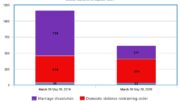Editor’s note: Sacramento County wants to reach less restrictive COVID-19 tier by Halloween. A new state equity requirement could make that more difficult.
Sacramento Public Health held events across the county on Oct. 1 to hand out decals and posters promoting a campaign to control COVID-19 cases—and reopen more businesses—by Halloween.
But the state may have just made that push more difficult with an overdue focus on reducing the pandemic’s disproportionate impact on people of color.
On Sept. 30, the California Department of Public Health unveiled a new equity metric that counties must meet to reopen more businesses and other places.
“Our entire state has come together to redouble our efforts to reduce the devastating toll COVID-19 has had on our Latino, Black and Pacific Islander communities,” Acting State Public Health Officer Erica Pan said in a statement. “This isn’t just a matter of higher cases in these communities—it is an issue of life and death that is hurting all Californians.”
In a statement Oct. 7, Sacramento Public Health said it “is working on the related information that is due when the County is ready to move to the next tier. Sacramento County is in a good position with the work we are doing with the community based organization – i.e., COLLAB, and the community testing sites to meet the criteria.”
UPDATE: As of Dec. 10, Latinos made up 57.5% of nearly 1.1 million cases and 48% of 20,424 deaths statewide, well above their 39% share of California’s population. African Americans were 7.6% of deaths, compared to 6% of the population.
UPDATE: As of Dec. 10 in Sacramento County, 30% of the county’s 46,479 COVID-19 cases and 20% of the 659 deaths were among Hispanics, compared to 24% of the county population. That case disparity has widened since late August, when Hispanics accounted for 18% of cases.
Also as of Dec. 10, African Americans were 12% of cases and 12% of deaths, compared to 11% of the total county population.
The new equity metric took effect Oct. 6, and is in addition to the existing measures of new case and test positivity rates.
As of Dec. 8, the equity test positivity rate was 13.7%, higher than the overall rate of 10.3%.
Under the equity metric, Sacramento and other counties of more than 106,000 people must show that test positivity rates in its most disadvantaged neighborhoods (the bottom 25% of census tracts in the state’s Healthy Places Index) are not significantly higher than the county overall. They must also submit a plan that defines its disproportionately impacted populations, looks at COVID-19 cases in these populations and outlines plans to stop transmission in these communities. That can include more testing, contact tracing, quarantine support and outreach to workers.
There is a carrot for success: If a county’s case rate isn’t declining enough to reach a less restrictive tier, it can still progress if test positivity rates both countywide and in disadvantaged neighborhoods fall into the rates for two tiers below. The equity metric, however, will not be considered whether a county has to move into a more restrictive tier.
Sacramento County had been stuck in the most restrictive purple tier since the state’s Blueprint for a Safer Economy took effect in late August. On Sept. 29, Sacramento County took a major step forward, moving to the less restrictive red tier. That allowed restaurants to offer indoor dining, but only at 25% capacity or 100 people, whichever is less. The same limits apply to movie theaters and places of worship.
All schools will be allowed to resume in-person classes only if the county stays in the red tier until Oct. 13, when Sacramento County plans to update its public health order.
The orange tier allows more kinds of businesses to open and eases capacity limits. The PR campaign slogan: “An Orange Sacramento County is an Open Sacramento County.”
UPDATE: County supervisors were told Oct. 6 that moving to orange will make sure that public health can do contact tracing without waiting.
As of Sept. 29, Sacramento County was at 6.6 new cases a day per 100,000 people and a 4.6% test positivity rate.
UPDATE: As of Oct. 6, the county had improved to 5.3 new cases a day and a 3.4% positivity rate.
To qualify for the orange tier, it would have to cut the numbers to fewer than 4 new cases a day and keep the test positivity rate below 5%.
To move forward, a county must meet the next tier’s criteria for two consecutive weeks, and a county must stay in a new less restrictive tier for at least three weeks. So the soonest Sacramento County could move to the orange tier is Oct. 20.
But seasonal flu season also starts this month, and that could cause another spike in COVID-19 cases—and stop Sacramento County from moving forward.
Bringing down the numbers in communities of color is crucial, and that’s been a concern for public health officials, along with elected and community leaders.
There are already efforts underway, and they become more important now.
On Sept. 18, the county and Center at Sierra Health Foundation announced Collab, a new partnership to offer more support to Latinos, Blacks and other ethnic groups. It includes contact tracers, resource coordinators and others who speak Spanish, Hmong and other languages to work with community members, business owners and essential workers at high risk of getting infected. Public health workers are collaborating with 13 neighborhood organizations.
Also, Sacramento County is planning to spend $7 million for housing to isolate agricultural and service industry workers who live in multi-generational households
And La Familia Counseling Center received $400,000 from the city to hire 25 people as contact tracers and other health workers to fight coronavirus in the Latino community.
A coalition of public health advocacy groups commended the state and Gov. Gavin Newsom for adding the equity measure.
“Communities of color are contracting COVID-19 and dying at disproportionate rates, largely due to our contributions to California’s economy as essential workers. The pandemic has laid bare the structural drivers of poor health outcomes and the weaknesses in both our social safety net and our public health infrastructure,” the California Pan-Ethnic Health Network, Health Access, Latino Coalition for a Healthy California, Prevention Institute and Public Health Advocates said in a joint statement.
“Requiring counties to demonstrate an improvement in the COVID-19 positivity rates in the neighborhoods facing the most severe impacts is both an essential and an attainable element of our pandemic response,” the statement added. “By focusing our collective resources on the health and safety of the communities most impacted by the pandemic, we can safely move to reopen our state.”






Be the first to comment on "Will California’s overdue equity push stall Sacramento’s reopening?"